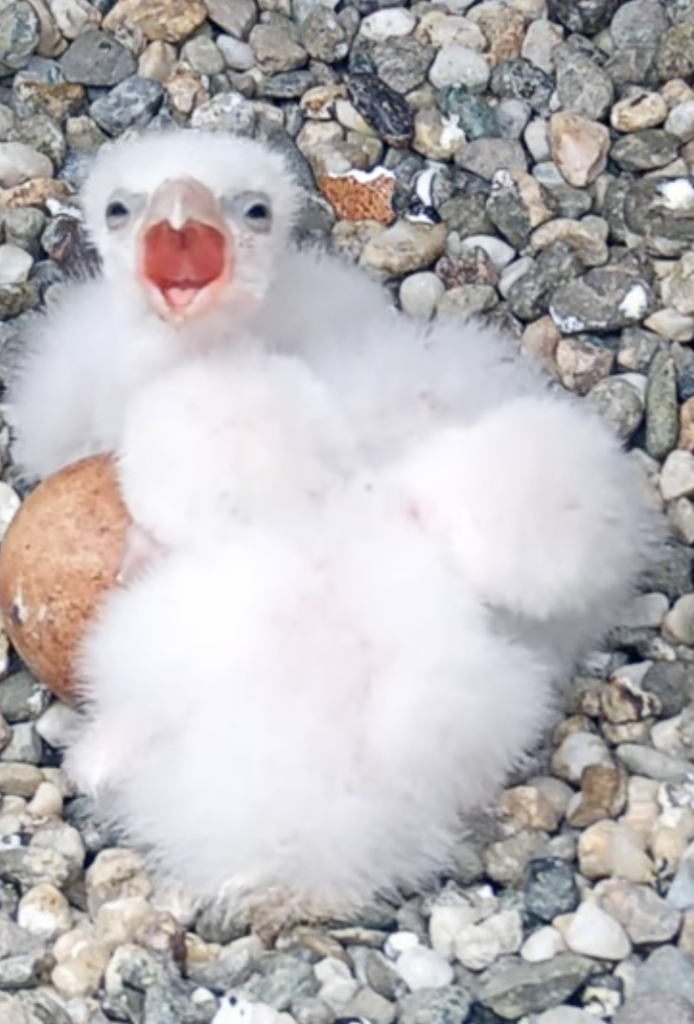
The Cal Falcons are hatching. Three fuzzy white chicks are tucked beneath their mother, Annie. A fourth egg may hatch soon. Annie dozes, white lids covering her open eyes. A stiff breeze ruffles her feathers as well as the debris scattered about the nesting box: feathers, bones, offal, the remains of songbirds. From time to time she opens her eyes, adjusts herself on her chicks, lifting her breast long enough for we viewers to get a glimpse of the hot pink feet and snow white fluff and startlingly red mouths of her brood.
These are peregrine falcons whose permanent home is a nesting box built into the Campanile on the UC Berkeley campus. Live Cams are trained on the nest and surrounding area. Fans of the Cal falcons can watch their progress online, from nesting to fledging, twenty-four hours a day. The nesting box and cameras are the result of a slow, organic process of crowd-sourced citizen science. You can read the history here.
The plight and regeneration of peregrine falcons in the American west is a story worth remembering in this time of environmental crisis. Briefly, as a result of the widespread use of DDT post-WWII, the shells of peregrine falcons thinned to the point where they were crumbling under the weight of a brooding adult. There was a catastrophic reduction in the number of surviving peregrines. This stunning raptor, who can achieve speeds up to 170 miles an hour in a stoop, was nearing extinction at a similar rate. It was the work of Rachel Carson, a book widely enough read, and a campaign wisely enough proffered, that curbed the use of DDT. As a result, the peregrine was able to rebound. The species is now repopulated and maintaining at viable rates.
Last year at this time, my partner was quarantined at home with Covid, and I—also exposed but not testing positive—was isolating in the cottage behind our house. I donned a mask, went into the house to fix my partner’s meals and take our dog for his five walks every day. The rest of the time, I holed up in the cottage, reading, writing, drawing, and watching the Cal falcons. I set my iPad up on the bed where I sat to work. It was on all day. I drew the chicks. They changed quickly. Dark steaks first appeared, edging their snowy tails and the tips of their wings. Day by day, a distinct pattern developed, laddering up their backs from tail to neck, the beginnings of the slate grey plumage of peregrinehood. They had distinct personalities. One was brash and greedy, first to gobble the food brought to them by their parents. One was competitive with its most aggressive sibling. The third was tender, often looking the other way while the first two gorged themselves on bloody bird bits. Despite these differences, they all survived, developed quickly, changing dramatically day to day.
Ellen Meloy, writer and naturalist, writes: “We plead for the life of one species as two become extinct before the end of our sentence. We frantically scribble nature odes and end up writing Obituaries of Place in desperate voices that sound like scorpions being pushed through glass tubes.”
She is right to raise the alarm. We are in the sixth major extinction which, in geologic time, will be an eon compared to our quick human lifespans. But we are losing tens of thousands of species annually, on track to lose 30-50% of all species by 2050, according to the 2019 United Nations report. This has happened five times previously, as far as we know. During the end of the Permian age, 250 million years ago, we lost 96% of species. The earth survived, but not as it had been. This moment, everything we have known as Earth for all of human history, is a quick and precious thing in the life of the planet.
The two Cal falcon parents work day and night. They take turns hunting to feed themselves and their brood. While one hunts, the other sits atop the chicks, keeping them warm and safe from predators. The male in this pair does the bulk of the hunting, but they do sometimes switch off. It is constant work to keep and protect three tiny vulnerable fuzzy chicks, to give them a chance to grow into adult raptors. All of this for one brood. Three chicks that, if they are lucky, will live for fifteen years.
We can’t all be Rachel Carson. We can’t all publish the papers that will unite scientists and the general public in a campaign to right an environmental disaster. But we can bring our awareness to the problem. We can expand the vigilance we bring to the care of our specific children to that of the whole environment. We can vote for measures and candidates that protect and conserve. We can insist that industry and economic policy align with environmental science. We can purchase those products whose manufacturers work green. We can offset the sometimes added expense of green products by using less. And we can all revel in the beauty of the natural world, close the gap that holds the natural world apart from human society. We are not separate from the natural world. We may sully this place that is our only place (SpaceX be damned), but we can also repair it.
What three things might you do this spring to nurture and protect this precious world?